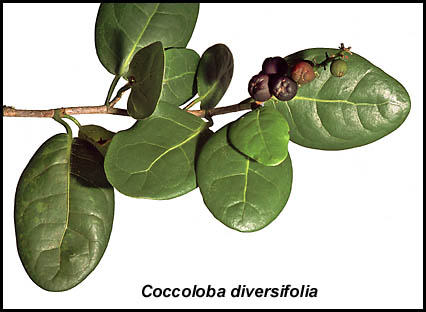Pigeon Plum
Coccoloba diversifolia
Family: Polygonaceae
Natural History

Pigeon plum, sometimes called doveplum and pigeon seagrape, is one of the larger seacoast trees found in central and southern Florida, the Keys, the West Indies, and the Bahamas. Pigeon plum is an excellent ornamental tree for yards and streets in south and central Florida coastal areas because of its resistance to high winds, salty conditions, and drought. It is tolerant of salt spray and often grows well in sandy, rocky, or broken coral soils near tidewater areas. Pigeon plum is recommended as a good hurricane resistant species for barrier plantings.
The fruit is eaten by numerous wildlife species, especially doves and pigeons, hence its common names. The white-crowned pigeon is a frequent visitor. Other wildlife that is known to eat the fleshy fruits and seeds include raccoons, small rodents, mockingbirds, catbirds, robins, and woodpeckers.
The heavy, dark, reddish-brown wood has some limited use in furniture manufacture and cabinetry. The wood is hard and strong but may be brittle, so its commercial value is limited.
Seagrape (Coccoloba uvifera) is a related tree that is also common in coastal areas in Florida. Seagrape is limited to beaches and dunes whereas pigeon plum grows more in coastal hammocks and sandy soils near tidewater. Both trees are frequently used in yards and streets in southern and central Florida.
